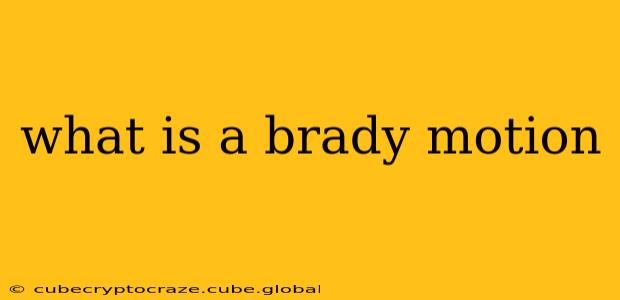A Brady motion, named after the landmark Supreme Court case Brady v. Maryland (1963), is a crucial part of the American criminal justice system. It's a pretrial motion filed by the defense attorney requesting the prosecution to disclose any exculpatory evidence—evidence that could help prove the defendant's innocence or reduce their sentence. This isn't just about minor details; it encompasses any information that could potentially affect the outcome of the case. Understanding its implications is vital for anyone involved in or interested in the legal process.
What Does Exculpatory Evidence Include?
The scope of exculpatory evidence is broad. It includes:
- Evidence that directly contradicts the prosecution's case: This might be witness statements that conflict with the prosecution's narrative, alternative explanations for the crime, or evidence suggesting the defendant was elsewhere at the time of the crime.
- Evidence that impeaches the credibility of prosecution witnesses: This could involve past criminal records of witnesses, inconsistencies in their statements, or evidence suggesting they have a motive to lie.
- Evidence that supports the defendant's alibi or alternative theory of the case: If the defendant claims they were somewhere else, evidence corroborating this claim is exculpatory.
- Evidence of police misconduct: This could include instances of coercion, fabrication of evidence, or violation of the defendant's rights.
- Information about deals or agreements with prosecution witnesses: If witnesses received promises of leniency in exchange for their testimony, the defense is entitled to know.
Why is a Brady Motion Important?
The Brady v. Maryland decision established a fundamental principle of due process: the prosecution has a duty to disclose material exculpatory evidence to the defense. Withholding such evidence violates the defendant's right to a fair trial and can lead to a wrongful conviction. The Brady motion serves as a mechanism to ensure this doesn't happen. It's a cornerstone of a just and equitable legal system.
What Happens if the Prosecution Fails to Disclose Exculpatory Evidence?
Failure to disclose exculpatory evidence can have serious consequences. Depending on the circumstances, it can lead to:
- Dismissal of charges: In some cases, the court may dismiss the charges entirely if the undisclosed evidence is deemed sufficiently material.
- Suppression of evidence: The court may rule that certain evidence obtained by the prosecution cannot be used at trial.
- New trial: If the undisclosed evidence is discovered after a conviction, it can lead to a new trial where the evidence is presented to the jury.
- Overturning of a conviction: In extreme cases, a conviction obtained through prosecutorial misconduct can be overturned on appeal.
How is a Brady Motion Filed?
The specific procedures for filing a Brady motion vary by jurisdiction, but generally, the defense attorney files a formal written motion with the court requesting the disclosure of all exculpatory evidence. The motion often specifies the types of evidence being sought. The prosecution is then required to respond, providing the requested evidence or explaining why it doesn't exist.
What are Some Common Mistakes in Brady Motions?
While the intent behind a Brady motion is clear, improper filing or execution can hinder its effectiveness. Common mistakes include:
- Being too vague or general in the request: The motion should clearly specify the types of evidence sought.
- Failing to follow court rules and procedures: Each jurisdiction has specific rules for filing motions, which must be meticulously followed.
- Not properly investigating potential exculpatory evidence: The defense must conduct thorough research to identify potential exculpatory evidence before filing the motion.
How Does a Brady Motion Differ From Other Motions?
A Brady motion focuses specifically on the prosecution's duty to disclose exculpatory evidence. Other pretrial motions may address different issues, such as:
- Motions to suppress evidence: These motions challenge the admissibility of evidence obtained illegally.
- Motions to dismiss: These motions argue that the charges should be dismissed for various reasons.
- Motions for discovery: While related, these motions seek broader disclosure of evidence than just exculpatory information.
In conclusion, the Brady motion is a vital mechanism ensuring fairness and justice in the criminal justice system. By demanding the disclosure of exculpatory evidence, it protects the rights of the accused and helps prevent wrongful convictions. Understanding its purpose and function is crucial for anyone seeking to navigate the intricacies of the legal process.
